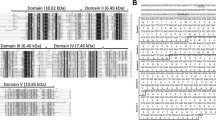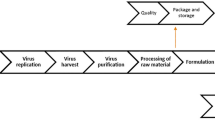Abstract
Baculoviral anti-apoptotic genes, p35 and iap (inhibitor of apoptosis), play important roles in the initiation stage of viral infection. While some iap genes in baculoviruses are not directly involved in anti-apoptotic activity, two iap genes (ly-iap2 and ly-iap3) were found and cloned from Lymantria xylina multiple nucleopolyhedrovirus (LyxyMNPV) and used to investigate the roles in LyxyMNPV infection. From the transcriptional start site analysis, ly-iap2 consisted of a late promoter motif (TAAG) located upstream at nt −17 bp, and ly-iap3 had a potential baculoviral promoter consensus sequence (GCTTGTT) located upstream at nt −44 bp. Both the ly-iap2 and ly-iap3 genes were initially transcribed in the LyxyMNPV-infected Ld652Y cells (IPLB-LD652Y cell line) at 3 h post infection (h p.i.), increased dramatically at 12 h p.i. and reached the peak at 72 h p.i. according to a quantitative RT-PCR (qRT-PCR) assay. Functional assays of these iap genes were performed using an overexpression method in Sf9 cells. Full-length LY-IAP2, LY-IAP3 and LY-IAP2-BIR (baculoviral IAP repeat) could inhibit varying degrees of apoptosis induced by Drosophila RPR protein (DRPR). Interestingly, Ly-IAP2-BIR showed higher inhibitory activity than full-length Ly-IAP2, and the protein expression level was dramatically increased while the Ly-IAP2-RING domain was deleted. The effect of MG-132 on the overexpression of Ly-IAP2 was investigated. Under MG-132 treatments, high-molecular-weight signals were also detected. Taken together, this study suggested that both Ly-IAP2 and Ly-IAP3 were anti-apoptotic protein through the BIR functional domain. The Ly-IAP2-RING domain was possibly involved in ubiquitin E3 ligase activity, leading to the degradation of Ly-IAP2 protein, whereas Ly-IAP3-RING might be working as a “helper domain” to inhibit DRPR-induced apoptosis.







Similar content being viewed by others
References
Birnbaum MJ, Clem RJ, Miller LK (1994) An apoptosis-inhibiting gene from a nuclear polyhedrosis virus encoding a polypeptide with Cys/His sequence motifs. J Virol 68:2521–2528
Bump NJ, Hackett M, Hugunin M, Seshagiri S, Brady K, Chen P, Ferenz C, Franklin S, Ghayur T, Li P et al (1995) Inhibition of ICE family proteases by baculovirus antiapoptotic protein p35. Science 269:1885–1888
Carpes MP, de Castro ME, Soares EF, Villela AG, Pinedo FJ, Ribeiro BM (2005) The inhibitor of apoptosis gene (iap-3) of Anticarsia gemmatalis multicapsid nucleopolyhedrovirus (AgMNPV) encodes a functional IAP. Arch Virol 150:1549–1562
Chen YR, Wu CY, Lee ST, Wu YJ, Lo CF, Tsai MF, Wang CH (2008) Genomic and host range studies of Maruca vitrata nucleopolyhedrovirus. J Gen Virol 89:2315–2330
Clem RJ (2007) Baculoviruses and apoptosis: a diversity of genes and responses. Curr Drug Targets 8:1069–1074
Clem RJ, Miller LK (1994) Control of programmed cell death by the baculovirus genes p35 and iap. Mol Cell Biol 14:5212–5222
Clem RJ, Fechheimer M, Miller LK (1991) Prevention of apoptosis by a baculovirus gene during infection of insect cells. Science 254:1388–1390
Crook NE, Clem RJ, Miller LK (1993) An apoptosis-inhibiting baculovirus gene with a zinc finger-like motif. J Virol 67:2168–2174
Deveraux QL, Reed JC (1999) IAP family proteins-suppressors of apoptosis. Genes Dev 13:239–252
Du Q, Lehavi D, Faktor O, Qi Y, Chejanovsky N (1999) Isolation of an apoptosis suppressor gene of the Spodoptera littoralis nucleopolyhedrovirus. J Virol 73:1278–1285
Eddins MJ, Lemongello D, Friesen PD, Fisher AJ (2002) Crystallization and low-resolution structure of an effector-caspase/P35 complex: similarities and differences to an initiator-caspase/P35 complex. Acta Crystallogr D Biol Crystallogr 58:299–302
Everett H, McFadden G (2001) Viruses and apoptosis: meddling with mitochondria. Virology 288:1–7
Fraser AG, James C, Evan GI, Hengartner MO (1999) Caenorhabditis elegans inhibitor of apoptosis protein (IAP) homologue BIR-1 plays a conserved role in cytokinesis. Curr Biol 9:292–301
Goodwin RH, Tompkins GJ, McCawley P (1978) Gypsy moth cell lines divergent in viral susceptibility I Culture and identification. In vitro 14:485–494
Goyal L, McCall K, Agapite J, Hartwieg E, Steller H (2000) Induction of apoptosis by Drosophila reaper, hid and grim through inhibition of IAP function. EMBO J 19:589–597
Green MC, Monser KP, Clem RJ (2004) Ubiquitin protein ligase activity of the anti-apoptotic baculovirus protein Op-IAP3. Virus Res 105:89–96
Harvey AJ, Soliman H, Kaiser WJ, Miller LK (1997) Anti- and pro-apoptotic activities of baculovirus and Drosophila IAPs in an insect cell line. Cell Death Differ 4:733–744
Hawkins CJ, Ekert PG, Uren AG, Holmgreen SP, Vaux DL (1998) Anti-apoptotic potential of insect cellular and viral IAPs in mammalian cells. Cell Death Differ 5:569–576
Hay BA, Wassarman DA, Rubin GM (1995) Drosophila homologs of baculovirus inhibitor of apoptosis proteins function to block cell death. Cell 83:1253–1262
Hink WF, Strauss ES (1976) Growth of the Trichoplusia ni (TN-368) cell line in suspension culture. Academic Press, New York
Herrmann M, Lorenz HM, Voll R, Grünke M, Woith W, Kalden JR (1994) A rapid and simple method for the isolation of apoptotic DNA fragments. Nucleic Acids Res 22(24):5506–5507
Huang Q, Deveraux QL, Maeda S, Salvesen GS, Stennicke HR, Hammock BD, Reed JC (2000) Evolutionary conservation of apoptosis mechanisms: lepidopteran and baculoviral inhibitor of apoptosis proteins are inhibitors of mammalian caspase-9. Proc Natl Acad Sci USA 97:1427–1432
Ikeda M, Yanagimoto K, Kobayashi M (2004) Identification and functional analysis of Hyphantria cunea nucleopolyhedrovirus iap genes. Virology 321:359–371
Kim YS, Xiao HZ, Du EQ, Cai GS, Lu SY, Qi YP (2007) Identification and functional analysis of LsMNPV anti-apoptosis genes. J Biochem Mol Biol 40:571–576
Kuzio J, Pearson MN, Harwood SH, Funk CJ, Evans JT, Slavicek JM, Rohrmann GF (1999) Sequence and analysis of the genome of a baculovirus pathogenic for Lymantria dispar. Virology 253:17–34
Leu JH, Kuo YC, Kou GH, Lo CF (2008) Molecular cloning and characterization of an inhibitor of apoptosis protein (IAP) from the tiger shrimp, Penaeus monodon. Dev Comp Immunol 32:121–133
Li F, Flanary PL, Altieri DC, Dohlman HG (2000) Cell division regulation by BIR1, a member of the inhibitor of apoptosis family in yeast. J Biol Chem 275:6707–6711
Liang C, de Lange J, Chen X, van Oers MM, Vlak JM, Westenberg M (2012) Functional analysis of two inhibitor of apoptosis (iap) orthologs from Helicoverpa armigera nucleopolyhedrovirus. Virus Res 165:107–111
Liu Q, Qi Y, Chejanovsky N (2003) Identification and classification of the Spodoptera littoralis nucleopolyhedrovirus inhibitor of apoptosis gene. Virus Genes 26:143–149
Luque T, Finch R, Crook N, O’Reilly DR, Winstanley D (2001) The complete sequence of the Cydia pomonella granulovirus genome. J Gen Virol 82:2531–2547
Maguire T, Harrison P, Hyink O, Kalmakoff J, Ward VK (2000) The inhibitors of apoptosis of Epiphyas postvittana nucleopolyhedrovirus. J Gen Virol 81:2803–2811
Means JC, Muro I, Clem RJ (2003) Silencing of the baculovirus Op-iap3 gene by RNA interference reveals that it is required for prevention of apoptosis during Orgyia pseudotsugata M nucleopolyhedrovirus infection of Ld652Y cells. J Virol 77:4481–4488
Nai YS, Wang TC, Chen YR, Lo CF, Wang CH (2009) A new nucleopolyhedrovirus strain (LdMNPV-like virus) with a defective fp25 gene from Lymantria xylina (Lepidoptera: Lymantriidae) in Taiwan. J Invertebr Pathol 102:110–119
Nai YS, Wu CY, Wang TC, Chen YR, Lau WH, Lo CF, Tsai MF, Wang CH (2010) Genomic sequencing and analyses of Lymantria xylina multiple nucleopolyhedrovirus. BMC Genom 11:116
O’Riordan MXD, Bauler LD, Scott FL, Duckett CS (2008) Inhibitor of apoptosis proteins in eukaryotic evolution and development: a model of thematic conservation. Dev Cell 15(4):497–508
O’Brien V (1998) Viruses and apoptosis. J Gen Virol 79(8):1833–1845
Sambrook J, Fritsch EF, Maniatis T (2001) Molecular cloning: A Laboratory Manual, 3rd edn. Cold Spring Harbor Laboratory Press, New York
Seshagiri S, Miller LK (1997) Baculovirus inhibitors of apoptosis (IAPs) block activation of Sf-caspase-1. Proc Natl Acad Sci USA 94:13606–13611
Seshagiri S, Vucic D, Lee J, Dixit VM (1999) Baculovirus-based genetic screen for antiapoptotic genes identifies a novel IAP. J Biol Chem 274:36769–36773
Summers MD, Smith GE (1987) A manual of methods for baculovirus vectors and insect cell culture procedures. Texas Agricul Exp Station Bull No. 1555
Tuller T, Waldman YY, Kupiec M, Ruppin E (2010) Translation efficiency is determined by both codon bias and folding energy. Proc Natl Acad Sci USA 107(8):3645–3650
Untergasser A, Cutcutache I, Koressaar T, Ye J, Faircloth BC, Remm M, Rozen SG (2012) Primer3—new capabilities and interfaces. Nucl Acids Res 40(15):e115
Vaux DL, Strasser A (1996) The molecular biology of apoptosis. Proc Natl Acad Sci USA 93:2239–2244
Vilaplana L, O’Reilly DR (2003) Functional interaction between Cydia pomonella granulovirus IAP proteins. Virus Res 92:107–111
Vucic D, Kaiser WJ, Harvey AJ, Miller LK (1997) Inhibition of reaper-induced apoptosis by interaction with inhibitor of apoptosis proteins (IAPs). Proc Natl Acad Sci USA 94:10183–10188
Wei Y, Fan T, Yu M (2008) Inhibitor of apoptosis proteins and apoptosis. Acta Biochim Biophys Sin (Shanghai) 40:278–288
Wright CW, Means JC, Penabaz T, Clem RJ (2005) The baculovirus anti-apoptotic protein Op-IAP does not inhibit Drosophila caspases or apoptosis in Drosophila S2 cells and instead sensitizes S2 cells to virus-induced apoptosis. Virology 335:61–71
Wu CY, Wang CH (2006) New cell lines from Lymantria xylina (Lepidoptera: Lymantriidae): characterization and susceptibility to baculoviruses. J Invertebr Pathol 93:186–191
Wu YL, Wu CP, Liu CY, Lee ST, Lee HP, Chao YC (2011) Heliothis zea nudivirus 1 gene hhi1 induces apoptosis which is blocked by the Hz-iap2 gene and a noncoding gene., pag1. J Virol 85:6856–6866
Xing K, Deng R, Wang J, Feng J, Huang M, Wang X (2005) Analysis and prediction of baculovirus promoter sequences. Virus Res 113:64–71
Yamada H, Shibuya M, Kobayashi M, Ikeda M (2011) Identification of a novel apoptosis suppressor gene from the baculovirus Lymantria dispar multicapsid nucleopolyhedrovirus. J Virol 85:5237–5242
Yamada H, Shibuya M, Kobayashi M, Ikeda M (2012) Baculovirus Lymantria dispar multiple nucleopolyhedrovirus IAP2 and IAP3 do not suppress apoptosis, but trigger apoptosis of insect cells in a transient expression assay. Virus Genes 45:370–379
Yan F, Deng X, Yan J, Wang J, Yao L, Lv S, Qi Y, Xu H (2010) Functional analysis of the inhibitor of apoptosis genes in Antheraea pernyi nucleopolyhedrovirus. J Microbiol 48:199–205
Yeh SC, Lee ST, Wu CY, Wang CH (2007) A cell line (NTU-MV) established from Maruca vitrata (Lepidoptera: Pyralidae): Characterization, viral susceptibility, and polyhedra production. J Invertebr Pathol 96:138–146
Yu Q, Lin T, Feng G, Yang K, Pang Y (2008) Functional analysis of the putative antiapoptotic genes, p49 and iap4, of Spodoptera litura nucleopolyhedrovirus with RNAi. J Gen Virol 89:1873–1880
Zeng X, Nan F, Liang C, Song J, Wang Q, Vlak JM, Chen X (2009) Functional analysis of the Autographa californica nucleopolyhedrovirus IAP1 and IAP2. Sci China C Life Sci 52:761–770
Acknowledgments
We appreciate Dr. Kuo-Ping Chiu at the Genomics Research Center, Academia Sinica, Taiwan, for providing the experimental reagents and Mr. Chong-Yu Ko and Ms. Po-Ya Hsu for their assistance with this work. This study was supported by grant 103-2313-B-197-002-MY3 from the National Science Council of Taiwan and a grant from the Council of Agriculture, Executive Yuan, Republic of China.
Author information
Authors and Affiliations
Corresponding authors
Additional information
Yu-Shin Nai and Yi-Ting Yang contributed equally as the first author.
Electronic supplementary material
Below is the link to the electronic supplementary material.
13355_2016_403_MOESM1_ESM.tiff
Supplement Fig. 1. Ly-IAP3-RING showed ubiquitination activity under proteasome inhibitor MG-132 treatment. Ly-iap3-RING transfected Sf9 cells were treated with DMSO (negative control) and 10 μM MG-132 after heat shock. At 1 h post-heat shock, the cell lysates were harvested and subjected to SDS/PAGE, and the gels were stained with Coomassie blue (loading control) or used for Western blot analysis with α-V5 antibody. A slight increase in the protein expression level was detected in MG-132-treated cells. (TIFF 835 kb)
Rights and permissions
About this article
Cite this article
Nai, YS., Yang, YT., Kim, J.S. et al. Baculoviral IAP2 and IAP3 encoded by Lymantria xylina multiple nucleopolyhedrovirus (LyxyMNPV) suppress insect cell apoptosis in a transient expression assay. Appl Entomol Zool 51, 305–316 (2016). https://doi.org/10.1007/s13355-016-0403-x
Received:
Accepted:
Published:
Issue Date:
DOI: https://doi.org/10.1007/s13355-016-0403-x




